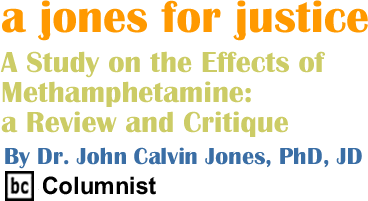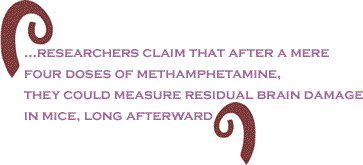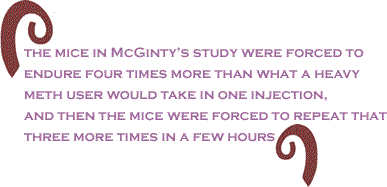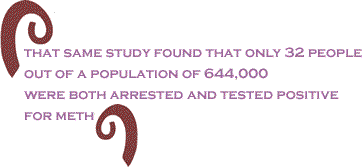
|
|||||||||||||||||||||
|
||||||||||
|
||||||||||
 |
||||||||||
 |
||||||||||
Summary of the Research On 14 August 2007, both the news wires and the Society of Neuroscience announced that Dr. Jacqueline McGinty and her colleagues made some new, important, scientific findings about the “long-term consequences of methamphetamine use.” We were told that McGinty found some of the neurological effects (i.e. brain damage) that methamphetamine causes.[1] In a study entitled, “Long-Term Consequences of Methamphetamine Exposure in Young Adults Are Exacerbated in Glial Cell Line-Derived Neurotrophic Factor Heterozygous Mice,” researchers claim that after a mere four doses of methamphetamine, they could measure residual brain damage in mice, long afterward (over nine months later).[2] The researchers then concluded, reasoning by analogy, that use of methamphetamine by humans will lead to brain damage that harkens Parkinson’s disease.[3] Reasons for Skepticism At a most basic level, there are methodological, political, and ethical critiques to question the validity and propriety of the study and the authors’ conclusions. First, McGinty et al. injected the mice with mega doses of methamphetamine, not doses comparable to what recreational or addicted users take. Second, after claiming that glial cell line-derived neurotrophic factor (GDNF) protects dopamine neurons from the toxic effects of methamphetamine, McGinty depleted the GDNF in one set of mice, administered the meth to them and then concluded that the meth (not their chemical imbalance) caused brain damage.[4] Given that the brains of humans are not altered to lower their GDNF, why should we believe the findings are applicable to people who use meth? Third, for over 100 years, the federal government has produced and or supported “research” that parrots the government position to vilify certain drugs and those populations who use them. More poignantly, the State of South Carolina and the USC medical center has recently been on the front lines of the prosecution of the War on Drugs, as opposed to addressing drug use issues as a medical matter. In this respect, this latest piece, funded by both the U.S. Army (which compels soldiers to consume amphetamines)[5] and the NIDA (a mouthpiece for American Drug War propaganda), compels us to question the research project period, much less its supposed results and speculative conclusions. Should We Find the Study Valid? It’s the Dosage Stupid! McGinty and her co-authors purport to tell us that typical doses of methamphetamines can have serious, long-lasting, deleterious effects on brain function to the point of causing Parkinson’s disease or Parkinson’s-like neurological impairment and disorder. However, instead of giving mice comparable doses as consumed by regular or infrequent meth users, McGinty et al. gave one set of mice four mega doses of methamphetamine.
Four times, McGinty’s team injected mice with 10 mg of meth per kg body weight, the latter three injections coming at two hour intervals after the first. If a person followed the same regime, how much meth would they take, following the McGinty binge? For a 110 pound woman (50 kg), at 10 mg per kg, she would be injected with 500 mg of meth – and then injected three more times over a period of six hours! The obvious question is, “would four doses of 500 mg of meth in six hours be a lot of meth for a 50 kg woman?” McGinty et al. fail to provide any mention on the propriety of their dosage and or how common it is for people to enjoy such mega doses. Though one might find a wide range of opinion as to what constitutes either a normal or mega-dose of methamphetamine, the evidence is relatively clear as to how much meth humans regularly consume. The DEA references an uncited NIDA report of 2006 which declares, “In some cases, abusers forego food and sleep while indulging in a form of binging known as a “run,” injecting as much as a gram of the drug every 2 to 3 hours over several days until the user runs out of the drug or is too disorganized to continue.”[6] (Nota bene: for some curious oddity, the NIDA report has no citations or references to bolster its claim about superhuman meth addicts who need as much as a gram at a time). Conversely, according to Erowid (2003)[7] a large dose of meth, taken intravenously, would be 50 mg. For even a regular user, 50 mg[8] would generate a high from one to three hours and the user would have another two to four hours to come down (Erowid 2003). Hence, if we follow the dictates of Erowid (2003), where a regular meth user might go seven hours between hits, we see that McGinty and company gave mice 10 times what a regular user needs and then re-administered the mega dose three more times within less than seven hours!
According to Wikipedia, intravenous meth users might use anywhere from 125 mg to 1g at a time. (As expected the Wikipedia entry gives no source to support the 1000 mg claim. However, recent revelations tell us that government officials doctor Wikipedia entries, so perhaps the 1g claim is tied to propagandists at the DEA and NIDA). Nevertheless, if we take the low-end Wikipedia estimate, the mice in McGinty’s study were forced to endure four times more than what a heavy meth user would take in one injection, and then the mice were forced to repeat that three more times in a few hours. To make another comparison, a quarter-gram (250 mg) of meth costs anywhere from $20-25.[9] Thus, we could establish such as a typical measure for a single dose. Moreover, no one can really be certain about the purity of such street drugs, but the mice in McGinty’s study were given unadulterated meth. There have been other documented cases of unadulterated meth use. During the time of the German Third Reich, German soldiers were given Pervitin (which had 3 mg of methamphetamine) and later, another drug that contained Pervitin called D-IX. D-IX had three significant psychoactive substances: cocaine (5 mg), methamphetamine (3 mg), and 5 mg of a morphine extract.[10] Soldiers and their commanders were advised to take only two pills (either the Pervitin or later the D-IX) per day as necessary to stave off sleepiness.[11] Therefore, while German soldiers weighing roughly 75 kg (165 lbs.) were taking not more than 12 mg of meth (orally) per day (two pills with 3 mg each, twice a day),[12] lab mice were injected with relatively 250 times as much, in one day! For one to ingest two hundred times too much water, coffee, aspirin, heroin, alcohol, etc. within a six hour period is enough to kill anyone. It is unremarkable that some researchers found evidence that defective mice would show signs of brain damage many months after what should have been a life ending meth binge.
And by no means were McGinty and her team without any guide as to how much meth other American scientists administer in their animal studies. In sharp contrast with McGinty et al., researchers at UCLA (2007) gave groups of monkeys a range from .2 mg/kg to .06 mg/kg of meth, no more than three times per day![13] They did, however, expose their animals to meth more often than McGinty did. The monkeys in the UCLA study were doped up 9-12 times per week for 6-8 weeks. What were their conclusions? The researchers concluded that while such meth exposure correlated strongly with behavioral changes, anti-social and more aggressive actions, the brains of the monkeys did NOT show extensive neurodegeneration. If one set of mammals were exposed to meth for a longer period, yet did not show the same types of disease as reported by McGinty et al., what can we conclude except that she poisoned her mice with mega doses of meth? Just Another Propaganda Study? On the surface, it is easy to see that McGinty and colleagues simply have produced another junk-science, pro-government Drug War propaganda piece. Recent history is filled with examples of similar efforts, with equally dubious results. In 1974 Dr. Robert Heath of Tulane University poisoned monkeys with carbon monoxide smoke produced by burning marijuana. Though Dr. Heath claimed that the marijuana itself produced brain damage, later investigation showed that Heath forced the monkeys to inhale the equivalent of smoke from 63 joints in five minutes and 30 joints a day for 90 days![14]
In 1989, without any scientific evidence, Dr. Ira Chasnoff, published a “study” where he proclaimed to have found a new phenomenon, the “crack baby.” That nearly all accounts of so-called crack babies were Black was omitted during that age of the CIA-crack connection, the Len Bias hype and the Reagan-Bush drug war against Blacks and Browns. Years later, however, when he and other neurologists approached the topic with some rigor and control, Chasnoff declared that there were no developmental effects from in utero cocaine exposure. Claiming that poverty, not crack, was the greatest determinant of brain development, Chasnoff wrote: “Their average developmental functioning level is normal. [In utero cocaine exposed children] are no different from other children growing up. They are not the retarded imbeciles [that] people talk about.”[15] In 2002, NIH sponsored researcher, George Ricaurte, announced to the world that recreational use of XTC (MDMA) leads to brain damage and that XTC use by teens would lead to Parkinson’s or other neuropsychiatric diseases in later life.[16] Like McGinty and Co., Ricaurte’s team poisoned monkeys with massive doses of XTC that they claimed were standard doses – in fact Ricaurte had no references to define what a baseline dose should be.[17] Voices opposed to the drug war responded immediately, attacking the methodology and conclusions of Ricaurte’s work. One year later, upon the discovered that he had not administered MDMA, Science itself retracted the article! In the early 1990s, at the same hospital from where McGinty and her team hail, the Medical University Hospital in Charleston, South Carolina, doctors and nurses on the maternity ward elected to work as an arm of the state in prosecuting the Drug War … and perpetuated the crack baby myths and stereotypes about crack and African-Americans at the same time. The Medical University Hospital instituted a policy of reporting on and facilitating the arrest of pregnant, primarily African-American patients who tested positive for cocaine. For four years, many African-American women were dragged out from the hospital, in chains.[18] The medical staff, working in collaboration with the prosecutor and police, conducted an “experiment” to see if arrests would reduce drug use by pregnant women. All but one of the thirty women arrested pursuant to the policy were African-American. The White nurse who implemented and ran the program admitted that she believed that mixing of the races was against God’s will and noted in the medical records of the one White woman they arrested, that she “lived with her boyfriend who is a Negro.” Despite claims to the contrary by hospital staff and the South Carolina Attorney General, most of the arrested mothers were never offered any drug treatment before being taken to jail.[19] News Flash: McGinty finds a drug epidemic
So, with this history, we must contextualize McGinty’s study and what she claims is the serious social need both to study meth and to warn us of its ills. In recent interviews, Dr. Jacqueline McGinty told reporters, “Methamphetamine intoxication in any young adult may have deleterious consequences later in life, though [the consequences might] not be apparent until many decades after the exposure. These studies speak directly to the possibility of long-term public health consequences resulting from the current epidemic [sic] of methamphetamine abuse among young adults.” What is the basis for McGinty, a medical doctor and researcher, to proclaim that South Carolina, or the United States, is suffering from a “meth epidemic”? There are a few ways to address the question. Let us start with a medical definition of an epidemic. As a baseline medical definition, an epidemic refers to the occurrence of more cases of a disease than would be expected in a community or region during a given time period. Included in the idea of an unexpectedly high rate of affliction, we expect to see abnormal or higher rates of mortality.[20] The threat of disease epidemics in crowded, densely populated or unsanitary conditions is particularly well illustrated in military history. On many occasions, a germ has been as important as the sword or gun in determining the outcome of a war. The Spanish conquest of Mexico owes much of its success to an epidemic of smallpox that destroyed about half the Aztec population.[21] The typhoid bacillus bacteria killed thousands during the American Civil War (1861-1865) and the Boer War (1899-1902) in South Africa.[22] Furthermore, the mortality rate from epidemic typhus increases with age. Over half of untreated persons age 50 or more die from typhus.[23]
Two other examples of epidemics include the Spanish flu and Bubonic plague. In 1918, some estimates find that 28% of all Americans were afflicted with the Spanish Flu.[24] The mortality rate associated with that flu outbreak was 2.5%.[25] The Bubonic plague (or Black plague) was responsible for two great pandemics. The first occurred from the Middle East to the Mediterranean basin during the 5th and 6th centuries AD, killing approximately 50% of the population. The second afflicted Europe between the 8th and 14th centuries, destroying nearly 40% of the population.[26] The Invisible Epidemic? While in the medical context, the use of the term epidemic is reserved for contagious diseases and or ailments associated with mortality. McGinty insists on using the inflammatory language in relation to a behavior that in no way is contagious - although arguably addictive for some individual users - and does not demonstrate excessive or high mortality rates. What does the data say about meth use? Or mortality rates associated with what McGinty calls a meth epidemic? Could we call meth addiction or use rates indicative of an epidemic that is wiping out populations, communities, and / or the nation? Or should we understand that a study which was lauded by Dr. Nora Volkow, the current head of the NIDA,[27] is merely spewing Drug War nonsense, designed to justify policies that have created a rise in the number of meth users? According to the 2006 edition of the annual study by the University of Michigan, Monitoring the Future (funded by the NIDA), less than 1% of American teens use meth monthly.[28] Another recent NIDA report (2003) found that in some parts of Nebraska, nearly 6% of arrestees, across five select counties, tested positive for methamphetamine.[29] But in raw numbers, that same study found that only 32 people out of a population of 644,000 were both arrested and tested positive for meth.[30] In December 2001, the federal National Drug Intelligence Center reported that meth use in South Carolina was far below that of other states![31] That said, in 2004, a total of 500 people sought treatment for meth addiction in South Carolina.[32] That is, 500 people in a population of over 4.3 million – or little more than 12 in 100,000 residents of the state. To compare, in an area of the country where meth is supposedly a visible problem, the Midwest, not even a rural state like Nebraska can show meth use rates of over 1% for the general population. Similarly, given that South Carolina has meth use rates below the national average, and the nation does not show teen meth use at even 1%, where is McGinty’s credibility in claiming there is a meth epidemic? Given the federal government’s own data on meth use, McGinty’s insistence on a meth epidemic is about as credible as G. W. Bush claiming that in 2003, the U.S. and her allies were under an imminent threat from Iraq’s non-existent stockpiles of nuclear weapons.
Similarly, the mortality rates in South Carolina have remained relatively steady over the past 15 years and trend lines show decreasing mortality.[33] In 1998, the State of South Carolina reported zero drug deaths / overdoses in teens. The same was true in 2004 (the last year for which data is available).[34] When McGinty cannot get the basics right, exaggerates or inflates claims, and is repeating old Drug War propaganda – as applied to a new drug, what should we believe? BC Columnist Dr John Calvin Jones, PhD, JD, has a law degree and a PhD in Political Science. His Website is virtualcitizens.com. Click here to contact Dr. Jones. [1] See Sara Harris. 2007. “Meth exposure in young adults leads to long-term behavioral consequences.” Society for Neuroscience, public release 14 August. Online at: http://www.eurekalert.org/pub_releases/2007-08/sfn-mei081307.php#. Contact Ms. Harris at [email protected]; or 202-962-4000 [2] Journal of Neuroscience, August 15, 2007, volume 27, number 33:8816-8825. Online at: http://www.jneurosci.org/cgi/content/abstract/27/33/8816. Received Aug. 11, 2006; revised June 11, 2007; accepted June 27, 2007. [3] Journal of Neuroscience, August 15, 2007, volume 27, number 33:8816-8825. Online at: http://www.jneurosci.org/cgi/content/abstract/27/33/8816. Received Aug. 11, 2006; revised June 11, 2007; accepted June 27, 2007. [4] Journal of Neuroscience, August 15, 2007, volume 27, number 33:8816-8825. Online at: http://www.jneurosci.org/cgi/content/abstract/27/33/8816. [5]Murdo Macleod. 2007. “UK troops receiving 'trigger happy' drug.” Scotsman Sunday, 10 July, http://news.scotsman.com/uk.cfm?id=906322007 [6] The report was first issued in 1998 and subsequently revised in 2002 and 2006. See National Institute on Drug Abuse, Research Report - Methamphetamine Abuse and Addiction, www.drugabuse.gov/ResearchReports/methamph/methamph.html [7] http://www.erowid.org/chemicals/meth/meth_dose.shtml [8] Editor’s note: Erowid does not present any consideration of bodyweight. [9] http://www.kci.org/meth_info/faq_meth.htm [10] Jeralyn (2005) at TalkLeft cites Ulrich (infra) and describes Pervitin as: “five milligrams of cocaine, three milligrams of Pervitin and five milligrams of Eukodal (a morphine-based painkiller).” See http://www.talkleft.com/story/2005/05/11/574/20039 [11] Andreas Ulrich. 2005. “The Nazi Death Machine: Hitler’s Drugged Soldiers.” Der Spiegel (The Mirror), 6 May. http://www.spiegel.de/international/0,1518,354606,00.html [12] Ulrich (2005). [13] See Melegal et al. 2007. “Long-Term Methamphetamine Administration in the Vervet Monkey Models Aspects of a Human Exposure: Brain Neurotoxicity and Behavioral Profiles,” Neuropsychopharmacology. Correspondence: Dr WP Melega, Department of Molecular and Medical Pharmacology, David Geffen School of Medicine at UCLA, Box 951735, 28-117 BRI, Los Angeles, CA 90095-1735; E-mail: [email protected] [14] Jack Herer. 2006. The Emperor Wears No Clothes. [15] http://www.druglibrary.org/schaffer/cocaine/crackbb2.htm [16] See Science, 26 September 2002. [17] http://stopthedrugwar.org/chronicle-old/257/fullofholes.shtml [18] Paltrow, Lynn. 1999. “Pregnant Drug Users, Fetal Persons, and the Threat to Roe v. Wade.” 62 Alb. L. Rev. 999, 1024-1025 [19] Paltrow, Lynn. 1999. “Pregnant Drug Users, Fetal Persons, and the Threat to Roe v. Wade.” 62 Alb. L. Rev. 999, 1024-1025 [20] http://www.medterms.com/script/main/art.asp?articlekey=3273 [21] http://www.answers.com/topic/epidemic?cat=health [22] http://www.answers.com/topic/epidemic?cat=health [23] http://www.medterms.com/script/main/art.asp?articlekey=5881 [24] http://virus.stanford.edu/uda/index.html [25] http://virus.stanford.edu/uda/index.html [26] http://www.emedicine.com/emerg/topic428.htm [27] See Sara Harris. 2007. “Meth exposure in young adults leads to long-term behavioral consequences.” Society for Neuroscience, public release 14 August. [28] http://www.nida.nih.gov/Infofacts/methamphetamine.html [29] http://www.ncjrs.gov/pdffiles1/nij/180986.pdf [30] http://quickfacts.census.gov/qfd/states/31000.html [31] http://www.usdoj.gov/ndic/pubs07/717/meth.htm [32] http://www.drug-rehabs.org/content.php?cid=1530&state=South%20Carolina [33] See South Carolina Vitality and Morbidity Statistics. |
||||||||||
| September
13, 2007 Issue 244 |
|
| Printer Friendly Version in resizeable plain text format format |
 |
 |
 |
| |
| |






































